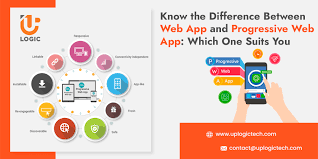
The Rise of Progressive Web App Development
Progressive Web Apps (PWAs) have been gaining momentum in the world of web development due to their ability to combine the best features of web and mobile applications. A PWA is a type of application software delivered through the web and built using common web technologies such as HTML, CSS, and JavaScript.
One key advantage of PWAs is their responsiveness and adaptability across various devices and screen sizes. They offer a seamless user experience similar to native mobile apps but without the need for installation from an app store.
Another important feature of PWAs is their offline functionality, allowing users to access certain features even when they are not connected to the internet. This is made possible through service workers, which cache data and enable offline access to previously visited content.
Furthermore, PWAs are known for their fast loading times and smooth performance, enhancing user engagement and retention. They can be easily shared via URL links, making them accessible to a wider audience without the barriers of traditional app distribution channels.
In terms of development, building a PWA involves implementing progressive enhancement principles to ensure that the app works on all devices regardless of browser capabilities. This includes using responsive design techniques and optimising performance for slower network connections.
Overall, progressive web app development offers a promising alternative for businesses looking to reach users across different platforms effectively. With their cross-platform compatibility, offline functionality, and improved performance, PWAs are reshaping the future of web applications.
Essential Tips for Developing Effective Progressive Web Apps
- 1. Ensure your PWA is mobile-responsive for a seamless user experience on all devices.
- 2. Implement service workers to enable offline functionality and faster loading times.
- 3. Utilize web app manifest to provide users with an app-like experience when accessing your PWA.
- 4. Optimize performance by lazy loading resources and minimizing network requests.
- 5. Secure your PWA with HTTPS to protect user data and ensure trustworthiness.
- 6. Focus on fast navigation and smooth animations to enhance user engagement.
- 7. Use push notifications to re-engage users and keep them informed of updates or new content.
- 8. Test your PWA across different browsers and devices to ensure compatibility and consistent performance.
- 9. Continuously monitor and analyze user feedback, metrics, and performance data to make improvements over time.
1. Ensure your PWA is mobile-responsive for a seamless user experience on all devices.
To create a successful Progressive Web App (PWA), it is crucial to prioritise mobile responsiveness. By ensuring that your PWA adapts seamlessly to various screen sizes and devices, you can provide users with a consistent and user-friendly experience. Mobile responsiveness not only enhances usability but also contributes to improved engagement and retention rates. Emphasising this aspect of development will help guarantee that your PWA delivers a high-quality experience across all platforms, ultimately leading to increased user satisfaction and success for your application.
2. Implement service workers to enable offline functionality and faster loading times.
To enhance the user experience and improve performance in progressive web app development, it is essential to implement service workers. By integrating service workers, developers can enable offline functionality and achieve faster loading times for the application. Service workers play a crucial role in caching data and resources, allowing users to access content even when offline and ensuring a seamless experience with quicker response times. This approach not only enhances user engagement but also contributes to the overall efficiency and reliability of the progressive web app.
3. Utilize web app manifest to provide users with an app-like experience when accessing your PWA.
By utilising the web app manifest, developers can enhance the user experience of their Progressive Web App (PWA) by providing users with an app-like experience when accessing the application. The web app manifest allows developers to define various settings such as the app’s name, icons, colours, and display modes. By configuring these settings in the manifest file, PWAs can offer a more immersive and cohesive experience for users, making them feel like they are interacting with a native mobile application rather than a traditional website.
4. Optimize performance by lazy loading resources and minimizing network requests.
To enhance the performance of a progressive web app, it is advisable to implement lazy loading techniques for resources and minimise network requests. By adopting lazy loading, resources such as images or scripts are only loaded when they are needed, reducing the initial load time of the application. Additionally, reducing network requests helps in improving overall speed and responsiveness by decreasing the amount of data that needs to be fetched from the server. These optimisation strategies contribute to a smoother user experience and faster loading times for progressive web apps.
5. Secure your PWA with HTTPS to protect user data and ensure trustworthiness.
Securing your Progressive Web App (PWA) with HTTPS is crucial for safeguarding user data and establishing trustworthiness. By encrypting the data transmitted between the user’s device and the server, HTTPS helps prevent malicious attacks and ensures the confidentiality and integrity of sensitive information. Additionally, displaying the padlock symbol in the browser address bar signifies a secure connection, reassuring users that their data is protected. Implementing HTTPS not only enhances the security of your PWA but also contributes to building credibility and trust with your audience.
6. Focus on fast navigation and smooth animations to enhance user engagement.
When developing a progressive web app, it is crucial to prioritise fast navigation and seamless animations to elevate user engagement. By ensuring swift transitions between pages and incorporating fluid animations, developers can create a more immersive and enjoyable user experience. These elements not only enhance the overall aesthetics of the app but also contribute to improved usability and retention rates. Prioritising fast navigation and smooth animations can significantly impact user satisfaction and encourage users to interact more actively with the app’s content.
7. Use push notifications to re-engage users and keep them informed of updates or new content.
Utilising push notifications is a valuable strategy in progressive web app development to re-engage users and provide them with timely updates or new content. By sending targeted notifications, businesses can effectively communicate with their audience, keeping them informed about important information and encouraging continued interaction with the app. This feature enhances user engagement and retention, ultimately contributing to a more dynamic and user-friendly experience within the progressive web application ecosystem.
8. Test your PWA across different browsers and devices to ensure compatibility and consistent performance.
It is crucial to test your Progressive Web App (PWA) across various browsers and devices to guarantee compatibility and consistent performance. By conducting thorough testing, you can identify any potential issues or discrepancies that may arise on different platforms. Ensuring that your PWA functions seamlessly across a range of browsers and devices will enhance user experience and help maximise its reach to a broader audience.
9. Continuously monitor and analyze user feedback, metrics, and performance data to make improvements over time.
Continuously monitoring and analysing user feedback, metrics, and performance data is crucial in the development of progressive web apps. By staying attentive to user responses and tracking key performance indicators, developers can identify areas for improvement and make informed decisions to enhance the overall user experience. This iterative process allows for ongoing refinement and optimisation of the PWA, ensuring that it remains responsive, engaging, and aligned with user expectations over time.

I’m extremely impressed together with your writing talents as well as with the structure on your weblog.
Is this a paid subject matter or did you modify it yourself?
Either way stay up the excellent quality writing, it is rare to see a great weblog
like this one today. Snipfeed!
Thank you for your kind words, Ivana! We’re glad you enjoyed the content on progressive web app development. The blogarticle aims to provide valuable insights into the world of PWAs and their benefits. We appreciate your feedback and hope to continue delivering informative and engaging content. If you have any further questions or topics you’d like us to cover, feel free to let us know!